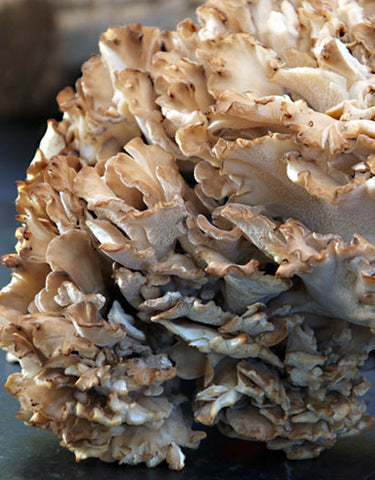Maitake Mushrooms
 ( Hen of The Woods )
( Hen of The Woods )
Grifola frondosa
Looking like a pullet hen that’s just fluffed its feathers and nestled down, the sun is just rising on this extraordinary mushroom’s culinary future in America. The phrase “too good to be true,” loops through the mind. The intense woodsy, smoky flavor of maitake is being overshadowed by its increasing importance as a medicinal mushroom. Life does seem fair after all when you savor a bite of roasted maitake on crostini and contemplate that anything so delicious is also good for you.
While the name “hen-of-the-woods” is obvious after looking at the mushroom, the name maitake is Japanese and means “dancing mushroom”. This name most likely refers to a clustering and fluttering of butterflies. The most often repeated story is that those who find it dance for joy, and the reward of finding it. It was at times, and to the right person, worth its weight in silver in medieval Japan.
An internet search on maitake brings up a staggering number of sites offering various capsules, teas, etc. with claims for a wide array of its health benefits. Probably 90% of the sites listed are about maitake’s medicinal qualities. There actually is mounting research to support its usefulness in treating hypertension, diabetes, high cholesterol, and tumors. While the claims and merits of this research are sorted out, maitake’s place in traditional Chinese and Japanese medicine has been secure for many centuries.
The 1979 maitake cultivation breakthrough in Japan brought this once uncommon mushroom into increasing prominence. In just a handful of years, American maitake growers are making this great mushroom available year round. Though found wild in the Eastern US in the autumn, the difficulty of cleaning the wild form has limited its popularity here. This is the only mushroom I actually prefer cultivated rather than wild. My grower selected a strain for flavor rather than for uniform large heads. While some wild maitake have a bitter flavor component, this cultivated strain does not.
|
Confusion The identification is easy (see David Arora’s Mushrooms Demystified). The name is hard. The name, hen-of-the-woods, is confused with another common mushroom “chicken-of-the-woods” Laetiporus sulfurous. My customers also confuse maitake with matsutake, an excellent but wildly different mushroom. If the true scientific names sounded nice on a menu, we wouldn’t have this problem. Harvesting It grows at the base of old decaying deciduous trees. It has a preference for oak trees in numerous countries. Like the cauliflower mushroom, it will reappear in the same place each autumn for many years. In the US it is fairly common in the Northeast. Seasonality Each autumn in the wild. Cooking Above all other methods, I recommend roasting. You can try this rich flavor by simply taking a small cluster (2”-3”) or breaking a large one. Place it in a little bowl shaped piece of foil, drizzle with a good oil or butter, salt & pepper, and roast in a 400 degree oven for 15-20 minutes. Let the outer petals get crispy. Eat this on grilled bread & you’ll have an excellent flavor profile of this species. The lack of meaty texture can be a virtue in many dishes. Its petals have made the finest pizza I’ve ever had, and one of the best risottos in memory. One restaurant smokes the maitake heads over tea leaves. Storage Hens are best stored in a bowl covered with a damp cloth, or carefully placed in a plastic bag kept open at the top- in the refrigerator, of course. Quality Make sure that the heads are firm and crisp. Any limpness or old beer aroma indicate an over-the-hill mushroom. The mushroom cluster should be thick with “petals”. Loose antler-like branches are not ideal. The color can range from light grey-brown to a dark grey. This wide color range is acceptable. |
